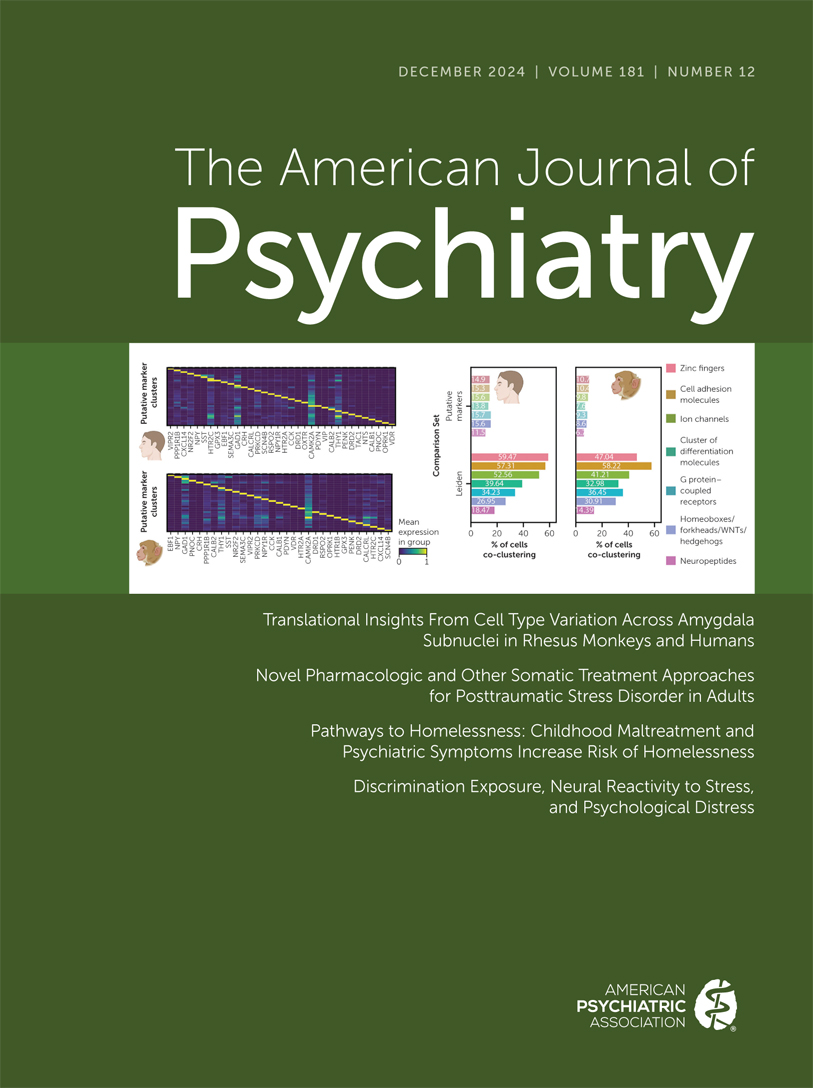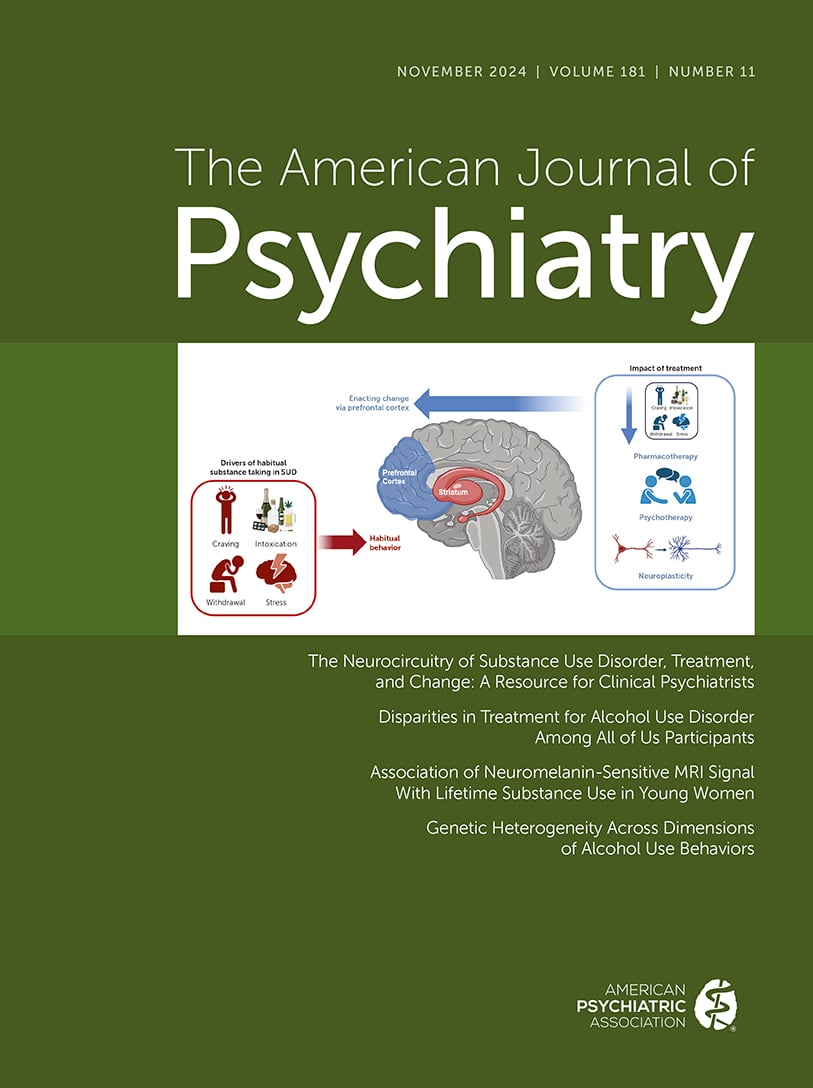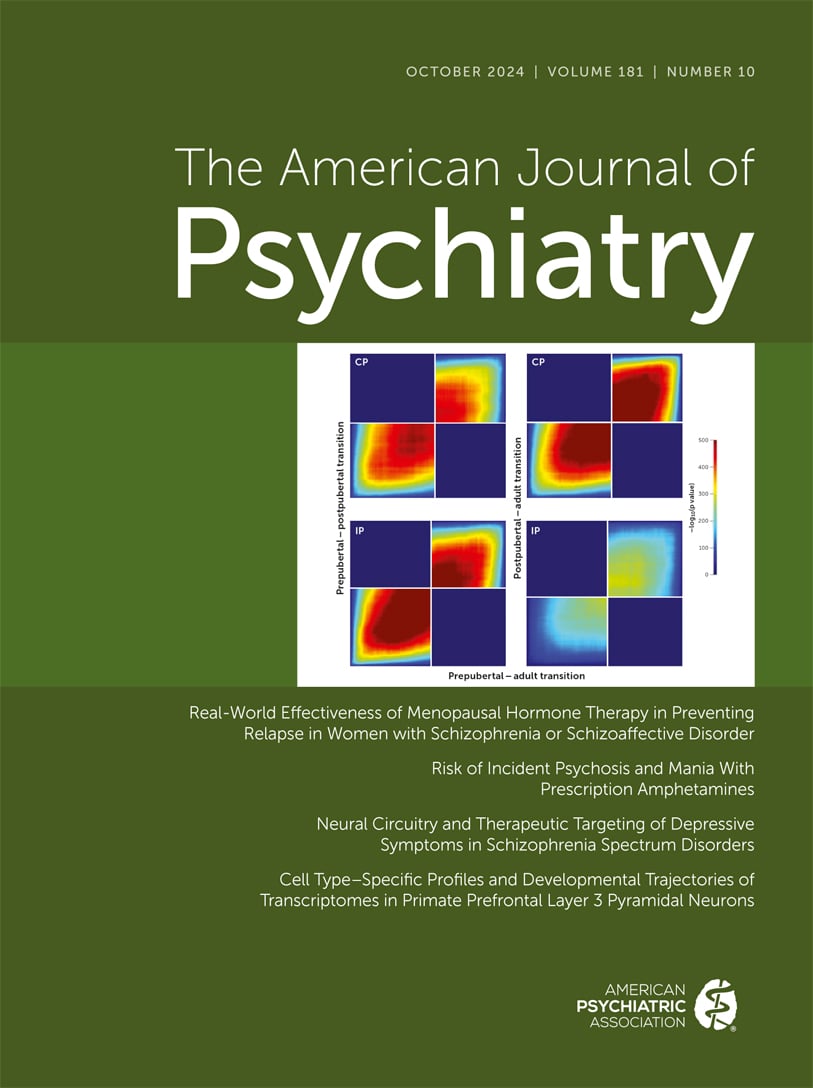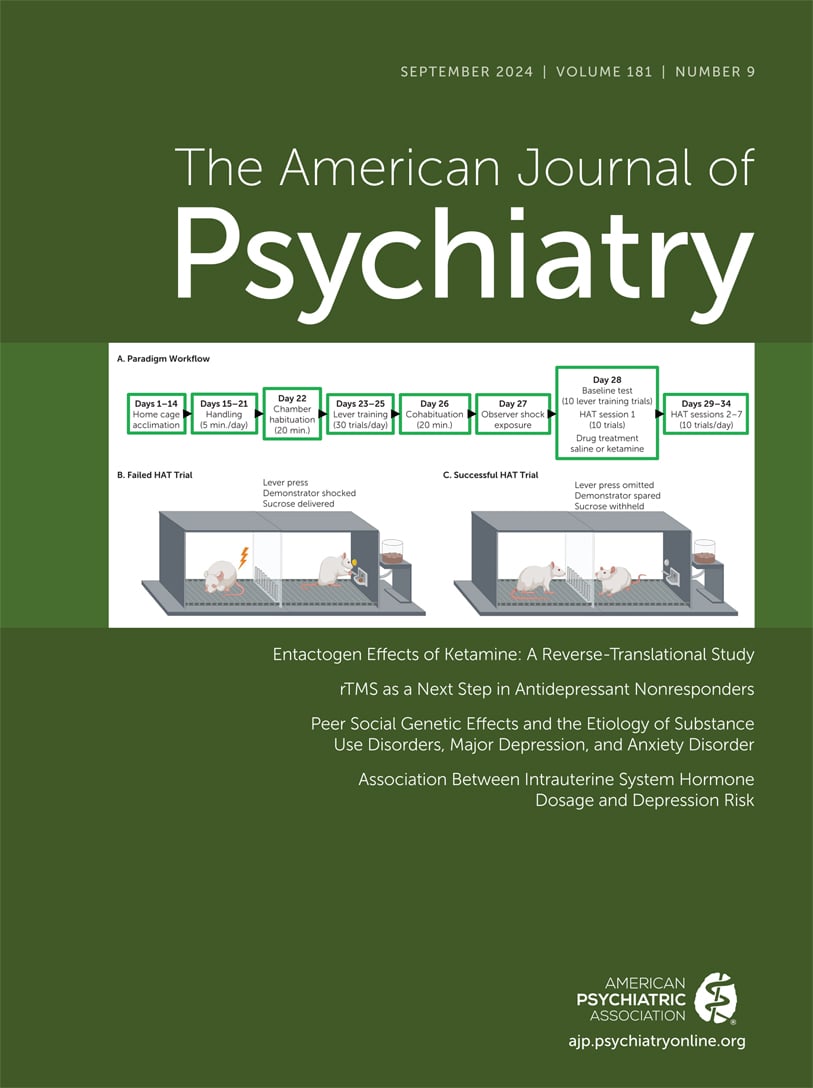American Journal of Psychiatry
- Volume 158
- Number 10
- October 2001
Editorial
Reviews and Overviews
Publication date: 01 October 2001
Pages1558–1567OBJECTIVE: The authors critically surveyed several preclinical and clinical neurobiological models of social anxiety disorder. METHOD: The authors reviewed the recent literature regarding three animal models of particular relevance to social anxiety. They ...
https://doi.org/10.1176/appi.ajp.158.10.1558Publication date: 01 October 2001
Pages1568–1578OBJECTIVE: The authors conducted meta-analyses of data from family and twin studies of panic disorder, generalized anxiety disorder, phobias, and obsessive-compulsive disorder (OCD) to explore the roles of genetic and environmental factors in their ...
https://doi.org/10.1176/appi.ajp.158.10.1568Publication date: 01 October 2001
Pages1579–1586OBJECTIVE: The authors reviewed the literature on mental health education for primary care physicians and made recommendations for the design of educational programs and research. METHOD: They searched the MEDLINE and PsycLIT databases from 1950 to 2000 ...
https://doi.org/10.1176/appi.ajp.158.10.1579Images in Neuroscience
Introspections
Clinical Case Conference
Images in Psychiatry
Presidential Paper
Article
Publication date: 01 October 2001
Pages1605–1611OBJECTIVE: Mania has received little attention from a contemporary neuropsychological perspective despite its clear resemblance to the disinhibition syndrome sometimes seen after frontal brain injury, particularly injury to the inferior aspect of the ...
https://doi.org/10.1176/appi.ajp.158.10.1605Publication date: 01 October 2001
Pages1612–1616OBJECTIVE: The theory that psychotic major depression is a distinct syndrome is supported by reports of statistically significant differences between psychotic and nonpsychotic major depression in presenting features, biological measures, familial ...
https://doi.org/10.1176/appi.ajp.158.10.1612Publication date: 01 October 2001
Pages1617–1622OBJECTIVE: The delayed onset of therapeutic response to antidepressants remains a major problem in the treatment of depression. Among the strategies to accelerate response to treatment, the early addition of thyroid hormone to antidepressants has been ...
https://doi.org/10.1176/appi.ajp.158.10.1617Publication date: 01 October 2001
Pages1623–1630OBJECTIVE: Depressed men commonly have erectile dysfunction, and men with erectile dysfunction are frequently depressed. Since the etiologic and modulatory relationships between depression and erectile dysfunction have been poorly characterized, a 12-week,...
https://doi.org/10.1176/appi.ajp.158.10.1623Publication date: 01 October 2001
Pages1631–1637OBJECTIVE: Pharmacological treatment of postpartum depression is frequently complicated by the mother’s desire to breast-feed. Although breast milk levels of several selective serotonin reuptake inhibitors (SSRIs) have been reported to be relatively low, ...
https://doi.org/10.1176/appi.ajp.158.10.1631Publication date: 01 October 2001
Pages1638–1644OBJECTIVE: The authors evaluated the incremental cost-effectiveness of stepped collaborative care for patients with persistent depressive symptoms after usual primary care management. METHOD: Primary care patients initiating antidepressant treatment ...
https://doi.org/10.1176/appi.ajp.158.10.1638Publication date: 01 October 2001
Pages1645–1651OBJECTIVE: Studies of patients with major depression in treatment settings have found significant residual symptoms and impairment after resolution of the depressive episode. However, only a small proportion of individuals with major depression seek ...
https://doi.org/10.1176/appi.ajp.158.10.1645Publication date: 01 October 2001
Pages1652–1658OBJECTIVE: Suicide rates differ between ethnic groups in the United States. Since suicide is commonly associated with a mood disorder, the authors compared suicide rates relative to depression rates in five ethnic groups in the United States. METHOD: ...
https://doi.org/10.1176/appi.ajp.158.10.1652Publication date: 01 October 2001
Pages1659–1665OBJECTIVE: Down’s syndrome, the most common genetic cause of mental retardation, results in characteristic physical and neuropsychological findings, including mental retardation and deficits in language and memory. This study was undertaken to confirm ...
https://doi.org/10.1176/appi.ajp.158.10.1659Publication date: 01 October 2001
Pages1666–1672OBJECTIVE: Familial risk analysis was used to clarify the relationship in girls between attention deficit hyperactivity disorder (ADHD) and learning disabilities in either mathematics or reading. METHOD: The authors assessed the presence of ADHD and ...
https://doi.org/10.1176/appi.ajp.158.10.1666Publication date: 01 October 2001
Pages1673–1679OBJECTIVE: The authors sought to examine psychopathological correlates of behavioral inhibition in young offspring of parents with panic disorder and/or major depression. METHOD: Behavioral inhibition, determined by using standard laboratory observations, ...
https://doi.org/10.1176/appi.ajp.158.10.1673Publication date: 01 October 2001
Pages1680–1686OBJECTIVE: The brain circuitry of opiate craving was investigated with positron emission tomography (PET) imaging of regional cerebral blood flow (rCBF). METHOD: Twelve abstinent opiate-dependent subjects listened to audiotaped autobiographical scripts of ...
https://doi.org/10.1176/appi.ajp.158.10.1680Publication date: 01 October 2001
Pages1687–1692OBJECTIVE: “Ecstasy,” or 3,4-methylenedioxymethamphetamine (MDMA), causes long-term impairment to the serotonin (5-HT) system in rats, dogs, and nonhuman primates. 5-HT dysfunction has also been observed in human recreational users of the drug, but ...
https://doi.org/10.1176/appi.ajp.158.10.1687Publication date: 01 October 2001
Pages1693–1700OBJECTIVE: The risks of heavy drinking and alcohol abuse/dependence were prospectively assessed among individuals with DSM-III social phobia and individuals with subclinical social phobia (irrational fear of social situations without significant ...
https://doi.org/10.1176/appi.ajp.158.10.1693Publication date: 01 October 2001
Pages1701–1705OBJECTIVE: Violent behavior may represent a risk factor for suicide. The authors tested the hypothesis that violent behavior in the last year of life is associated with completed suicide, even after controlling for alcohol use disorders. METHOD: The ...
https://doi.org/10.1176/appi.ajp.158.10.1701Publication date: 01 October 2001
Pages1706–1713OBJECTIVE: Comorbidity of substance abuse disorders with schizophrenia is associated with a greater risk for serious illness complications and poorer outcome. Methodologically sound studies investigating treatment approaches for patients with these ...
https://doi.org/10.1176/appi.ajp.158.10.1706Brief Report
Publication date: 01 October 2001
Pages1714–1716OBJECTIVE: The pathophysiology of neuroleptic malignant syndrome is mainly explained by a central hypodopaminergic state. The familial occurrence of neuroleptic malignant syndrome suggests the involvement of a genetic mechanism in the predisposition to ...
https://doi.org/10.1176/appi.ajp.158.10.1714Publication date: 01 October 2001
Pages1717–1719OBJECTIVE: High-resolution magnetic resonance imaging was used to evaluate the prevalence of the cavum septi pellucidi (CSP) in 79 normal subjects and 86 patients with schizophrenia. METHOD: The CSP was assessed by counting the number of consecutive ...
https://doi.org/10.1176/appi.ajp.158.10.1717Publication date: 01 October 2001
Pages1719–1722OBJECTIVE: The goal of this study was to explore the pathophysiology of weight gain during treatment with olanzapine for schizophrenia. METHOD: The authors used a prospective, controlled, open study comparing body weight, body mass index, and related ...
https://doi.org/10.1176/appi.ajp.158.10.1719Publication date: 01 October 2001
Pages1722–1725OBJECTIVE: The goal of this study was to evaluate the effects of the addition of tandospirone, a serotonin-1A (5-HT1A) agonist, to ongoing treatment with typical antipsychotic drugs, on two cognitive domains that are relevant to functional outcome in ...
https://doi.org/10.1176/appi.ajp.158.10.1722Publication date: 01 October 2001
Pages1725–1727OBJECTIVE: The effectiveness of pindolol as an adjunctive treatment to boost response to selective serotonin reuptake inhibitors (SSRIs) in patients with generalized social phobia was tested. METHOD: A double-blind, placebo-controlled, crossover design ...
https://doi.org/10.1176/appi.ajp.158.10.1725Publication date: 01 October 2001
Pages1728–1730OBJECTIVE: Because there are no studies available on the safety of venlafaxine during pregnancy, the authors’ goal in this study was to determine whether venlafaxine increases the risk for major malformations. METHOD: Data on 150 women exposed to ...
https://doi.org/10.1176/appi.ajp.158.10.1728Lack of Association Between Parental Alcohol or Drug Addiction and Behavioral Inhibition in Children
Publication date: 01 October 2001
Pages1731–1733OBJECTIVE: “Behavioral inhibition to the unfamiliar” has been proposed as a precursor to anxiety. A recent study proposed that it may also be a precursor to alcoholism. The authors sought to replicate the latter finding through a secondary analysis of ...
https://doi.org/10.1176/appi.ajp.158.10.1731Publication date: 01 October 2001
Pages1733–1735OBJECTIVE: The authors’ goal was to determine the frequency of psychiatric comorbidity among treatment-seeking pathological gamblers, compare the severity of gambling and psychological problems in gamblers with and without comorbid disorders, and ...
https://doi.org/10.1176/ajp.158.10.1733Letter to the Editor
Book Forum: The Brain and Mental Illness
Book Forum: Psychoanalysis
Book Forum: Biological Psychiatry
Book Forum: Disorders of Appetite and Reward Systems
Book Forum: Personality and Personality Disorders
Book Forum: Psychopathy and Violence
Book Forum: Suicide
Book Forum
Past Issues
View Issues Archive
Vol. 181 | No. 12

Vol. 181 | No. 11

Vol. 181 | No. 10
